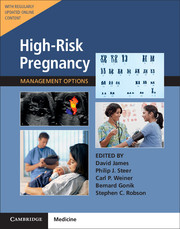Book contents
- Frontmatter
- Contents
- List of Contributors
- Preface
- Section 1 Prepregnancy Problems
- Section 2 Early Prenatal Problems
- 5 Bleeding and Pain in Early Pregnancy
- 6 Recurrent Miscarriage
- 7 Screening for Fetal Abnormality in the First and Second Trimesters
- 8 Invasive Procedures for Prenatal Diagnosis
- Section 3 Late Prenatal – Fetal Problems
- Section 4 Problems Associated with Infection
- Section 5 Late Pregnancy – Maternal Problems
- Section 6 Late Prenatal – Obstetric Problems
- Section 7 Postnatal Problems
- Section 8 Normal Values
- Index
6 - Recurrent Miscarriage
from Section 2 - Early Prenatal Problems
- Frontmatter
- Contents
- List of Contributors
- Preface
- Section 1 Prepregnancy Problems
- Section 2 Early Prenatal Problems
- 5 Bleeding and Pain in Early Pregnancy
- 6 Recurrent Miscarriage
- 7 Screening for Fetal Abnormality in the First and Second Trimesters
- 8 Invasive Procedures for Prenatal Diagnosis
- Section 3 Late Prenatal – Fetal Problems
- Section 4 Problems Associated with Infection
- Section 5 Late Pregnancy – Maternal Problems
- Section 6 Late Prenatal – Obstetric Problems
- Section 7 Postnatal Problems
- Section 8 Normal Values
- Index
Summary
Introduction
Definitions and Prevalence of Miscarriage (see also Chapter 5)
The two commonest definitions of spontaneous miscarriage are as follows
• Traditionally, it has been defined as the spontaneous loss of an intrauterine pregnancy before the age of viability, with the age of viability starting at 24+0 weeks of pregnancy.
• However, while the age of viability at present is set at 24+0 weeks, improvements in neonatal care will, in time, change this. Thus, the WHO defines miscarriage as the “expulsion from its mother of an embryo or fetus weighing 500 grams or less, corresponding to a gestational age of up to 20 completed weeks of gestation with no signs of life.”
Miscarriages can be subdivided according to the gestation when the pregnancy “fails.” A simple classification is:
• early miscarriage – up to and including 12+6 weeks
• late miscarriage – after 12+6 weeks
A more detailed classification is:
• preembryonic miscarriage (< 5+6 weeks)
• embryonic miscarriage (6 to 10+6 weeks)
• fetal loss (11 to 20+6 or 23+6 weeks, depending on which threshold for viability is used)
• stillbirth (> 20+6 or 23+6 weeks, depending on which threshold for viability is used)
It has been reported that between 8% and 20% of women who know they are pregnant have a miscarriage some time before 20 weeks of pregnancy. Eighty percent of reported miscarriages occur in the first 12 weeks.1 However, the actual rate of miscarriage is probably much higher, as many women have very early miscarriages without knowing they are pregnant. For example, an actual miscarriage rate of 31% has been reported when pregnancy has been documented using β-hCG levels. This incidence is much lower (5%) in women who have previously had a baby.
After 15 weeks the overall risk of spontaneous miscarriage is even lower (about 0.6%) for chromosomally and structurally normal fetuses. However, it varies according to maternal age and ethnicity.
Definitions and Prevalence of Recurrent Miscarriage
Recurrent miscarriage (RM) is defined conventionally as the loss of three or more consecutive pregnancies. This affects about 1–3% of women of reproductive age trying to conceive. However, there are further differences in definitions, depending on whether the miscarriages are consecutive with no live births in between. Some have amended the definition even further to include women with two miscarriages. This affects 5% of women trying to conceive.
- Type
- Chapter
- Information
- High-Risk Pregnancy: Management OptionsFive-Year Institutional Subscription with Online Updates, pp. 114 - 148Publisher: Cambridge University PressFirst published in: 2017



